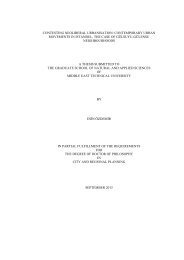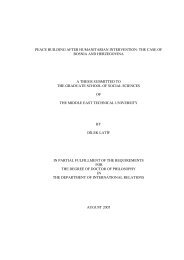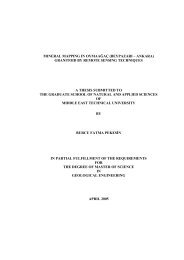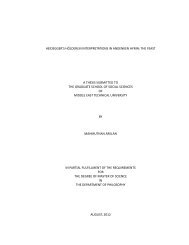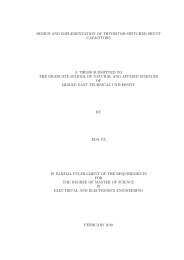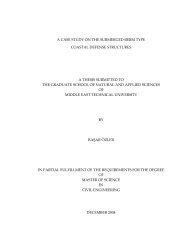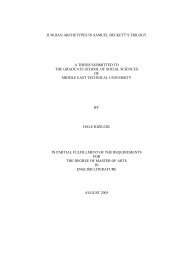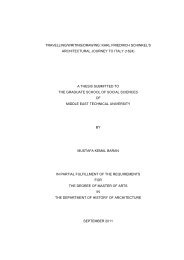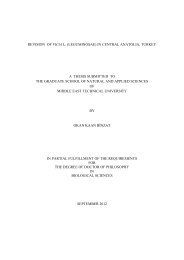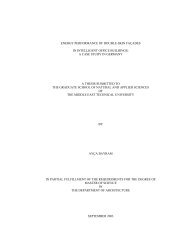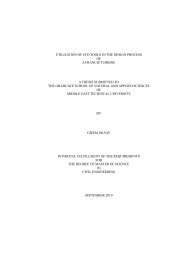a framework for developing conceptual models of the mission space ...
a framework for developing conceptual models of the mission space ...
a framework for developing conceptual models of the mission space ...
You also want an ePaper? Increase the reach of your titles
YUMPU automatically turns print PDFs into web optimized ePapers that Google loves.
As we completed <strong>the</strong> first case study we realized that per<strong>for</strong>ming verification and validation<br />
activities after <strong>the</strong> first release <strong>of</strong> <strong>the</strong> <strong>conceptual</strong> model would be an effective way to determine <strong>the</strong><br />
defects earlier. There<strong>for</strong>e, we decided to add a review step be<strong>for</strong>e <strong>the</strong> “refine <strong>the</strong> <strong>conceptual</strong><br />
model” step. This might be a joint review with <strong>the</strong> domain experts, so that both modelers and<br />
domain experts would ensure that <strong>the</strong>y speak in <strong>the</strong> same language. Formal review techniques<br />
employing checklists might be used <strong>for</strong> verification and structured walkthroughs might be used <strong>for</strong><br />
validation purposes.<br />
Verification results revealed that <strong>developing</strong> <strong>the</strong> <strong>conceptual</strong> <strong>models</strong> in a diagrammatic modeling<br />
language and using a tool that supports this language helped <strong>the</strong> modelers in describing<br />
relationships, navigating among <strong>the</strong> model elements, communicating <strong>the</strong> model and finding<br />
mistakes. We also observed that using intuitive graphical notations would increase <strong>the</strong><br />
effectiveness <strong>of</strong> <strong>the</strong> verification process.<br />
5.4. Case Study 2<br />
5.4.1. Background<br />
One <strong>of</strong> <strong>the</strong> objectives <strong>of</strong> this <strong>the</strong>sis was providing a suitable notation both <strong>for</strong> development and<br />
usage <strong>of</strong> <strong>the</strong> <strong>conceptual</strong> <strong>models</strong>. There<strong>for</strong>e, we decided to conduct <strong>the</strong> second case study in an<br />
organization where we could have <strong>the</strong> modelers develop <strong>the</strong> model and domain experts use <strong>the</strong><br />
model. The purpose <strong>of</strong> <strong>the</strong> case study was to explore and evaluate <strong>the</strong> sufficiency <strong>of</strong> <strong>the</strong> KAMA<br />
notation <strong>for</strong> <strong>developing</strong> and validating <strong>conceptual</strong> <strong>models</strong> <strong>of</strong> <strong>the</strong> <strong>mission</strong> <strong>space</strong>s.<br />
We conducted <strong>the</strong> case study in a s<strong>of</strong>tware development company with 50+ s<strong>of</strong>tware and systems<br />
developers. The company focuses on defense projects with major interest in simulation and<br />
in<strong>for</strong>mation systems. Most <strong>of</strong> <strong>the</strong> s<strong>of</strong>tware engineers have graduate degrees and are experienced in<br />
simulation systems development. Although <strong>the</strong>y had experience in simulation development, <strong>the</strong>y<br />
did not follow a defined <strong>conceptual</strong> modeling process in <strong>the</strong>ir previous modeling experience. The<br />
project has been estimated to last <strong>for</strong> 3 years, and an iteration will be released at <strong>the</strong> end <strong>of</strong> each<br />
year. A <strong>conceptual</strong> modeling phase has been planned <strong>for</strong> each iteration which is followed by a<br />
system requirements analysis phase. The <strong>conceptual</strong> modeling team consisted <strong>of</strong> 10 s<strong>of</strong>tware<br />
engineers and <strong>the</strong> acquirer organization provided support to <strong>the</strong> team when required.<br />
The <strong>conceptual</strong> modeling team consisted <strong>of</strong> 6 members from <strong>the</strong> team <strong>of</strong> a simulation development<br />
project, targeted <strong>for</strong> <strong>developing</strong>/enhancing a system <strong>for</strong> Turkish Military Forces. Two <strong>of</strong> <strong>the</strong>m<br />
were senior team leaders with more than 12 years <strong>of</strong> experience and <strong>the</strong> rest <strong>of</strong> <strong>the</strong> team were<br />
senior s<strong>of</strong>tware engineers who were specialized in modeling and simulation.<br />
116



